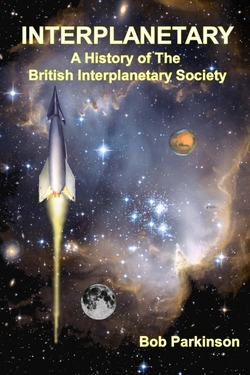Centauri Dreams
Imagining and Planning Interstellar Exploration
Infrastructure and the Interstellar Probe
The question of infrastructure haunts the quest to achieve interstellar flight. I’ve always believed that we will develop deep space capabilities not only for research and commerce but also as a means of defense, ensuring that we will be able to change the trajectories of potentially dangerous objects. But consider the recent Breakthrough Starshot discussion. There I noted that we might balance the images we could receive through Starshot’s sails with those we could produce through telescopes at the Sun’s gravitational focus.
Without the infrastructure issue, it would be a simple thing to go with JPL’s Solar Gravitational Lens concept since the target, somewhere around 600 AU, is so much closer, and could produce perhaps even better imagery. But let’s consider Starshot’s huge photon engine in the Atacama desert not as a one-shot enabler for Proxima Centauri, but as a practical tool that, once built, will allow all kinds of fast missions within the Solar System. The financial outlay supports Oort Cloud exploration, fast access to the heliopause and nearby interstellar space, and planetary missions of all kinds. Add atmospheric braking and we can consider it as a supply chain as well.
Robert Freeland, who has labored mightily in the Project Icarus Firefly design, told the Interstellar Research Group’s recent meeting in Montreal about work he is doing within the context of the British Interplanetary Society’s BIS SPACE project, whose goal is to consider the economic drivers, resources, transportation issues and future population growth that would drive an interplanetary economy. That Solar System-wide infrastructure in turn feeds interstellar capabilities, as it generates new technologies that funnel into propulsion concepts. A case in point: In-space fusion.
To make our engines go, we need fuel, an obvious point and a telling one, since the kind of fusion Freeland has been studying for the Firefly design is limited by our current inability to extract enough Helium-3 to use aboard an interstellar craft. Firefly would use Z-pinch fusion – this is a way of confining plasma and compressing it. An electrical current fed into the plasma generates the magnetic fields that ‘pinch,’ or compress the plasma, creating the high temperatures and pressures that can produce fusion.
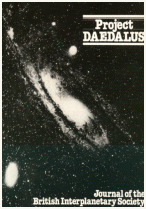
I was glad to see Freeland’s slides on the fusion fuel possibilities, a helpful refresher. The easiest fusion reactions, if anything about fusion can be called ‘easy,’ is that of deuterium with tritium, with the caveat that this reaction produces most of its energies in neutrons that cannot produce thrust. Whereas the reaction of deuterium with helium-3 releases primarily charged particles that can be shaped into thrust, which is why it was D/He3 fusion that was chosen by the Daedalus team for their gigantic starship design back in the 1970s. Along with that choice came the need to find the helium-3 to fuel the craft. The Daedalus team, ever imaginative, contemplated mining the atmospheres of the gas giants, where He3 can be found in abundance.
The lack of He-3 caused Icarus to choose a pure deuterium fuel (DD). Freeland ran through the problems with DD, noting the abundance of produced neutrons and the gamma rays that result from shielding these fast neutrons. The reaction also produces so-called bremsstrahlung radiation, which emerges in the form of x-rays. Thus the Firefly design stripped down what would otherwise be a significant portion of its mass in shielding by going to what Freeland calls ‘distance shielding,’ meaning minimal structure that allows the radiation to escape into space.
A starship using deuterium and helium-3 minimizes the neutron radiation, so the question becomes, when do we close the gap in our space capabilities to the point that we can extract helium-3 in the quantities needed from planets like Uranus? I see BIS SPACE as seeking to probe what the Daedalus team described as a Solar System-wide economy, and to put some numbers to the question of when this capability would evolve. The question is given point in terms of interstellar probes because while Firefly had been conceived as a starship that could launch before 2100, it seemed likely that helium-3 simply wouldn’t be available in sufficient quantities. So when would it be?
To create an infrastructure off-planet, we’ll need human migration outward, beginning most likely with orbital habitats not far from Earth – think of the orbital environments conceived by Gerard O’Neill, with their access to the abundant resources of the inner system. Freeland imagines future population growth moving further out over the course of the next 20,000 years until the Solar System is fully exploited. In four waves of expansion, he sees the era of chemical and ion rocketry, and perhaps beamed propulsion, to about 2050, with the second generation largely using fission-powered craft, in a phase ending in about 2200. 2200 to 2500 taps fusion energies (DD), while the entire Solar System is populated after 2500, with mining of the gas giants possible.
Let’s pause for a moment on the human population’s growth, because the trends noted in the image below, although widely circulated, seem not to be widely known. We’re looking here at the growth rate of our species and its acceleration followed by its long decline. As Freeland pointed out, the UN expects world population to peak at between 10 and 12 billion perhaps before the end of this century. After that, increase in the population is by no means assured. So much for the scenario that we have to go off-planet because we will simply overwhelm resources here with our numbers.

Image: In both this and the image below I am drawing from Freeland’s slides.
You would think this Malthusian notion would have long ago been discredited, but it is surprisingly robust. Even so, orbital habitats near Earth can potentially re-create basic Earth-like conditions while exploiting material resources in great abundance and solar power, with easy access to space for moving the wave of innovation further out. BIS SPACE looks with renewed interest at these O’Neill habitats in its first wave of papers.
The larger scenario plays out as follows: In the second half of our century, we move development largely to high Earth orbit, with materials drawn mostly from the Moon, using transport of goods by nuclear-powered cargo ships. The third generation creates orbital habitats at all the inner planets (and Ceres) and perhaps near-Earth asteroids using DD fusion propulsion, while the fourth generation takes in the outer planets and their moons. At this point we can set up the kind of aerostat mining rigs in the upper gas giant atmospheres that would enable the collection of helium-3. Here again we have to make comparisons with other technologies. Where will beamed spacecraft capabilities be by the time we are actively mining He-3 in the outer Solar System?
I’ve simplified the details on expansion greatly, and send you to Freeland’s slides for the details. But I want to circle back to Firefly. Using DD fusion, Firefly’s radiator and coolant requirements are extreme (480 tonnes of beryllium coolant!) But move to the deuterium/helium-3 reaction and you drop radiation output by 75 percent while increasing exhaust velocity. Beryllium can be replaced with less expensive aluminum and the physical size of the vessel is greatly reduced. This version of Firefly gets to Alpha Centauri in the same time using 1/5th the fuel and 1/12th the coolant.

In other words, the sooner we can build the infrastructure allowing us to mine the critical helium-3, the sooner we can drop the costs of interstellar missions and expand their capabilities using fusion engines. If such a scenario plays out, it will be fascinating to see how the population growth curves for the entire Solar System track given access to abundant new resources and the technologies to exploit them. If we can imagine a Solar System-wide human population in the range of 100 billion, we can also imagine the growth of new propulsion concepts to power colonization outside the system.

Reflections on Breakthrough Starshot
If we’re going to get to the stars, the path along the way has to go through an effort like Breakthrough Starshot. This is not to say that Breakthrough will achieve an interstellar mission, though its aspirational goal of reaching a nearby star like Proxima Centauri with a flight time of 20 years is one that takes the breath away. But aspirations are just that, and the point is, we need them no matter how far-fetched they seem to drive our ambition, sharpen our perspective and widen our analysis. Whether we achieve them in their initial formulation cannot be known until we try.
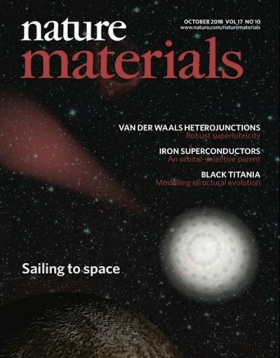
So let’s talk for a minute about what Starshot is and isn’t. It is not an attempt to use existing technologies to begin building a starship today. Yes, metal is being bent, but in laboratory experiments and simulated environments. No, rather than a construction project, Starshot is about clarifying where we are now, and projecting where we can expect to be within a reasonable time frame. In its early stages, it is about identifying the science issues that would enable us to use laser beaming to light up a sail and push it toward another star with prospects of a solid data return. Starshot’s Harry Atwater (Caltech) told the Interstellar Research Group in Montreal that it is about development and definition. Develop the physics, define and grow the design concepts, and nurture a scientific community. These are the necessary and current preliminaries.
Image: The cover image of a Starshot paper illustrating Harry Atwater’s “Materials Challenges for the Starshot Lightsail,” Nature Materials 17 (2018), 861-867.
We’re talking about what could be a decades-long effort here, one that has already achieved a singular advance in interstellar studies. I don’t have the current count on how many papers have been spawned by this effort, but we can contrast the ongoing work of Starshot’s technical teams with where interstellar studies was just 25 years ago, when few scientific conferences dealt with interstellar ideas and exoplanets were still a field in their infancy. In terms of bringing focus to the issue, Starshot is sui generis.
It is also an organic effort. Starshot will assess its development as it goes, and the more feasible its answers, the more it will grow. I think that learning more about sail possibilities will spawn renewed effort in other areas, and I see the recent growth of fusion rocketry concepts as a demonstration that our field is attaining critical mass not only in the research labs and academy but in commercial space ventures as well.
So let’s add to Atwater’s statement that Starshot is also a cultural phenomenon. Although its technical meetings are anything but media fodder, their quiet work keeps the idea of an interstellar crossing in the public mind as a kind of background musical riff. Yes, we’re thinking about this. We’ve got ideas and lab experiments that point to new directions. We’re learning things about lightsails and beaming we didn’t know before. And yes, it’s a big universe, with approximately one planet per star on average, and we’ve got one outstanding example of a habitable zone planet right next door.
So might Starshot’s proponents say to themselves, although I have no idea how many of those participating in the effort back out sometimes to see that broader picture (I suspect quite a few, based on those I know, but I can’t speak for everyone). But because Starshot has not sought the kind of publicity that our media-crazed age demands, I want to send you to Atwater’s video presentation at Montreal to get caught up on where things stand. I doubt we’re ever going to fly the mission Starshot originally conceived because of cost and sheer scale, but I’m only an outsider looking in. I do think that when the first interstellar mission flies, it will draw heavily on Starshot’s work. And this will be true no matter what final choices emerge as to propulsion.
This is a highly technical talk compressed into an all too short 40 minutes, but let’s just go deep on one aspect of it, the discussion of the lightsail that would be accelerated to 20 percent of lightspeed for the interstellar crossing. Atwater’s charts are worth seeing, especially the background on what the sail team’s meetings have produced in terms of their work on sail materials and, especially, sail shape and stability. The sail is a structure approximately 4 meters in diameter, with a communications aperture 1 meter in size, as seen in the center of the image (2 on the figure). Surrounding it on the circular surface are image sensors (6) and thin-film radioisotope power cells (5).
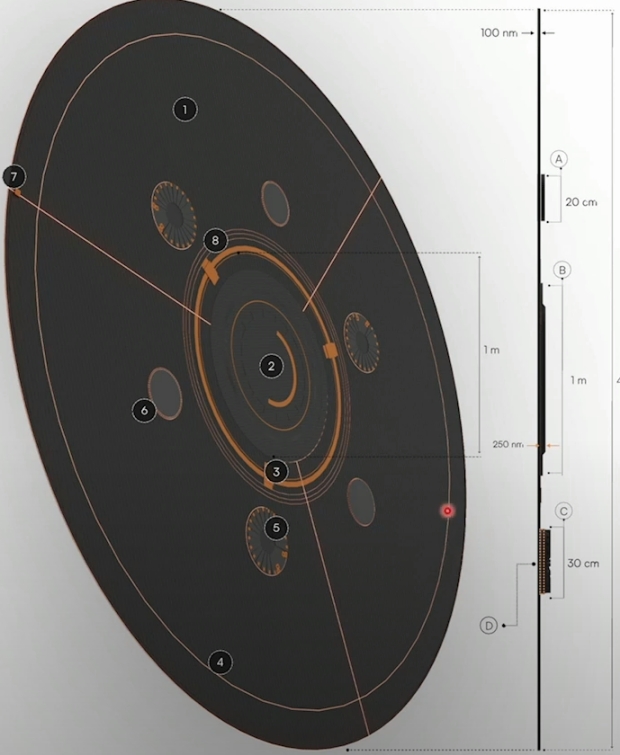
Maneuvering LEDs (4) provide attitude control, and thin-film magnetometers (7) are in the central disk, with power and data buses (8) also illustrated. A key component: A laser reflector layer positioned between the instruments that are located on the lightsail and the lightsail itself, which is formed as a silicon nitride metagrating. As Atwater covers early in his presentation, the metagrating is crucial for attitude control and beam-riding, keeping the sail from slipping off the beam even though it is flat. The layering is crucial in protecting the sailcraft instrumentation during the acceleration stage, when it is fully illuminated by the laser from the ground.
How to design lensless transmitters and imaging apertures? Atwater said that lensless color camera and steerable phased array communication apertures are being prototyped in the laboratory now using phased arrays with electrooptic materials. Working one-dimensional devices have emerged in this early work for beam steering and electronic focusing of beams. The laser reflector layer offers the requisite high reflectivity at the laser wavelength being considered, using a hybrid design with silicon nitride and molybdenum disulfide to minimize absorption that would heat the sail.
I won’t walk us through all of the Starshot design concepts at this kind of detail, but rather send you to Atwater’s presentation, which shows the beam-riding lightsail structure and its current laboratory iterations. The discussion of power sources is particularly interesting given the thin-film lightweight structures involved, and as shown in the image below, it involves radioisotope thermoelectric generators actually integrated into the sail surface. Thin film batteries and fuel cells were considered by Breakthrough’s power working group but rejected in favor of this RTG design.
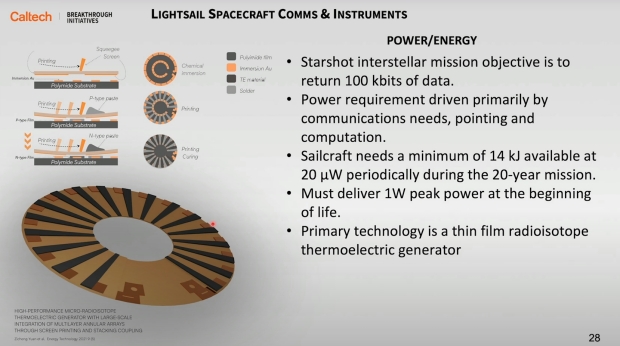
So much is going on here in terms of the selection of sail materials and the analysis of its shape, but I’ll also send you to Atwater’s presentation with a recommendation to linger over his discussion of the photon engine, that vast installation needed to produce the beam that would make the interstellar mission happen. The concept in its entirety is breathtaking. The photon engine is currently envisioned as an array of 1,767,146 panels consisting of 706,858,400 individual tiles (Atwater dryly described this as “a large number of tiles”), producing the 200 gW output and covering 3 kilometers on the ground. The communications problem for data return is managed by scalable large-area ground receiver arrays, another area where Breakthrough is examining cost trends that within the decades contemplated for the project will drive component expenses sharply down. The project depends upon these economic outcomes.
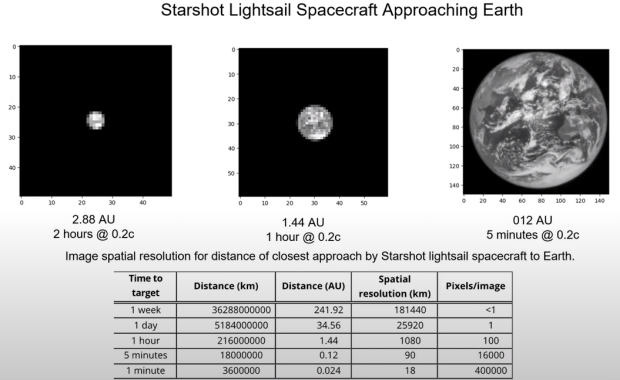
Image: What we would see if we had a Starshot-class sailcraft approaching the Earth, from the image at two hours away to within five minutes of its approach. Credit for this and the two earlier images: Harry Atwater/Breakthrough Starshot.
Using a laser-beamed sail technology to reach the nearest stars may be the fastest way to get images like those above. The prospect of studying a planet like Proxima b at this level of detail is enticing, but how far can we count on economic projections to bring costs down to the even remotely foreseeable range? We also have to factor in the possibility of getting still better images from a mission to the solar gravitational lens (much closer) of the kind currently being developed at the Jet Propulsion Laboratory.
Economic feasibility is inescapably part of the Starshot project, and is clearly one of the fundamental issues it was designed to address. I return to my initial point. Identifying the principles involved and defining the best concepts to drive design both now and in the future is the work of a growing scientific community, which the Starshot effort continues to energize. That in itself is no small achievement.
It is, in fact, a key building block in the scientific edifice that will define the best options for achieving the interstellar dream. And while this is not the place to go into the complexities of scientific funding, suffice it to say that putting out the cash to enable these continuing studies is a catalytic gift to a field that has always struggled for traction both financial and philosophical. The Starshot initiative has a foundational role in defining the best technologies for interstellar flight that will lead one day to its realization.

Braking at Centauri: A Bound Orbit at Proxima?
One of the great problems of lightsail concepts for interstellar flight is the need to decelerate. Here I’m using lightsail as opposed to ‘solar sail’ in the emerging consensus that a solar sail is one that reflects light from our star, and is thus usable within the Solar System out to about 5 AU, where we deal with the diminishment of photon pressure with distance. Or we could use the Sun with a close solar pass to sling a solar sail outbound on an interstellar trajectory, acknowledging that once our trajectory has been altered and cruise velocity obtained, we might as well stow the now useless sail. Perhaps we could use it for shielding in the interstellar medium or some such.
A lightsail in today’s parlance defines a sail that is assumed to work with a beamed power source, as with the laser array envisioned by Breakthrough Starshot. With such an array, whether on Earth or in space, we can forgo the perihelion pass and simply bring our beam to bear on the sail, reaching much higher velocities. Of the various materials suggested for sails in recent times, graphene and aerographite have emerged as prime candidates, both under discussion at the recent Montreal symposium of the Interstellar Research Group. And that problem of deceleration remains.
Is a flyby sufficient when the target is not a nearby planet but a distant star? We accepted flybys of the gas giants as part of the Voyager package because we had never seen these worlds close up, and were rewarded with images and data that were huge steps forward in our understanding of the local planetary environment. But an interstellar flyby is challenging because at the speeds we need to reach to make the crossing in a reasonable amount of time, we would blow through our destination system in a matter of hours, and past any planet of interest in perhaps a matter of minutes.

Robert Forward’s ingenious ‘staged’ lightsail got around the problem by using an Earth-based laser to illuminate one part of the now separated sail ring, beaming that energy back to the trailing part of the sail affixed to the payload and allowing it to decelerate. Similar contortions could divide the sail again to make it possible to establish a return trajectory to Earth once exploration of the distant stellar system was complete. We can also consider using magsail concepts to decelerate, or perhaps the incident light from a bright target star could allow sufficient energy to brake against.
Image: Forward’s lightsail separating at the beginning of its deceleration phase. Laser sailing may turn out to be the best way to the stars, provided we can work out the enormous technical challenges of managing the outbound beam. Or will we master fusion first? Credit: R.L. Forward.
But time is ever a factor, because you want to reach your target quickly, while at the same time, if you approach it too fast, you’re incapable of creating the needed deceleration. Moreover, what is your target? A bright star gives you options for deceleration if you approach at high velocity that are lacking from, say, a red dwarf star like Proxima Centauri, where the closest terrestrial-class world we know is in what appears to be a habitable zone orbit. In Montreal, René Heller (Max Planck Institute for Solar System Research), a familiar name in these pages, laid out the equations for a concept he has been developing for several years, a mission that could use not only the light of Proxima itself but from Centauri A and B to create a deceleration opportunity. You can follow Heller’s presentation at Montreal here.
Remember what we’re dealing with here. We have two stars in the central binary, Centauri A (G-class) and Centauri B (K-class), with the M-class dwarf Proxima Centauri about 13000 AU distant. Centauri A and B are close – their distance as they orbit around a common barycenter varies from 35.6 AU to 11.2 AU. These are distances in Solar System range, meaning that 35.6 AU is roughly the orbit of Neptune, while 11.2 AU is close to Saturn distance. Interesting visual effects in the skies of any planet there.

Image: Orbital plot of Proxima Centauri showing its position with respect to Alpha Centauri over the coming millennia (graduations are in thousands of years). The large number of background stars is due to the fact that Proxima Cen is located very close to the plane of the Milky Way. Proxima’s orbital relation to the central stars becomes profoundly important in the calculations Heller and team make here. Credit: P. Kervella (CNRS/U. of Chile/Observatoire de Paris/LESIA), ESO/Digitized Sky Survey 2, D. De Martin/M. Zamani.
Using a target star for deceleration by braking against incident photons has been studied extensively, especially in recent years by the Breakthrough Starship team, where the question of how its tiny sailcraft could slow from 20 percent of the speed of light to allow longer time at target is obviously significant. Deceleration into a bound orbit at Proxima would be, of course, ideal but it turns out to be impossible given the faint photon pressure Proxima can produce. Investing decades of research and 20 years of travel time is hardly efficient if time in the system is measured in minutes.
In fact, to use photon pressure from Proxima Centauri, whose luminosity is 0.0017 that of the Sun, would require approaching the star so slowly to decelerate into a bound orbit that the journey would take thousands of years. Hence Heller’s notion of using the combined photon pressure and gravitational influences of Centauri A and B to work deceleration through a carefully chosen trajectory. In other words, approach A, begin deceleration, move to B and repeat, then emerge on course outbound to Proxima, where you’re now slow enough to use its own photons to enter the system and stay.
Working with Michael Hippke (Max Planck Institute for Solar System Research, Göttingen) and Pierre Kervella (CNRS/Universidad de Chile), Heller has refined the maximum speed that can be achieved on the approach into Alpha Centauri A to make all this happen: 16900 kilometers per second. If we launch in 2035, we arrive at Centauri A in 2092, with arrival at Centauri B roughly six days later and, finally, arrival at Proxima Centauri for operations there in a further 46 years. That launch time is not arbitrary. Heller chose 2035 because he needs Centauri A and B to be in precise alignment to allow the gravitational and photon braking effects to work their magic.
So we have backed away from Starshot’s goal of 20 percent of lightspeed to a more sedate 5.6 percent, but with the advantage (if we are patient enough) of putting our payload into the Proxima Centauri system for operations there rather than simply flying through it at high velocity. We also get a glimpse of the systems at both Centauri A and B. I wrote about the original Heller and Hippke paper on this back in 2017 and followed that up with Proxima Mission: Fine-Tuning the Photogravitational Assist. I return to the concept now because Heller’s presentation contrasts nicely with the Helicity fusion work we looked at in the previous post. There, the need for fusion to fly large payloads and decelerate into a target was a key driver for work on an in-space fusion engine.
Interstellar studies works, though, through multiple channels, as it must. Pursuing fusion in a flight-capable package is obviously a worthy goal, but so is exploring the beamed energy option in all its manifestations. I note that Helicity cites a travel time to Proxima Centauri in the range of 117 years, which compares with Heller and company’s now fine-tuned transit into a bound orbit at Proxima of 121 years. The difference, of course, is that Helicity can envision launching a substantially larger payload.
Clearly the pressure is on fusion to deliver, if we can make that happen. But the fact that we have gone from interstellar flight times thought to involve thousands of years to a figure of just over a century in the past few decades of research is heartening. No one said this would be easy, but I think Robert Forward would revel in the thought that we’re driving the numbers down for a variety of intriguing propulsion options.
The paper René Heller drew from in the Montreal presentation is Heller, Hippke & Kervella, “Optimized Trajectories to the Nearest Stars Using Lightweight High-velocity Photon Sails,” Astronomical Journal Vol. 154 No. 3 (29 August 2017), 115. Full text.

Interstellar Path? Helicity’s Bid for In-Space Fusion
Be aware that the Interstellar Research Group has made the videos shot at its Montreal symposium available. I find this a marvelous resource, and hope I never get jaded with the availability of such materials. I can remember hunting desperately for background on talks being given at astronomical conferences I could not attend, and this was just 20 years ago. Now the growing abundance of video makes it possible for those of us who couldn’t be in Montreal to virtually attend the sessions. Nice work by the IRG video team!
There is plentiful material here for the interstellar minded, and I will be drawing on this resource in days ahead. But let’s start with fusion, because it’s a word that all too easily evokes a particular reaction in those of us who have been writing about the field for some time. Fusion has always seemed to be the flower about to bloom, even as decades of research have passed and the target of practical power generation hovers in the future. In terms of propulsion, I’ve long felt that if we had so much trouble igniting fusion on Earth, how much longer would it be before we could translate our knowledge into the tight dimensions of a drive for an interstellar spacecraft?
But if you’ll take a look at Helicity Space’s presentation at the Montreal symposium, you’ll learn about a tightly focused company that approaches fusion from a different direction. Rather than starting with fusion reactors designed to produce power on Earth, Helicity’s entire focus is building a fusion drive for space. NASA’s Alan Stern, of New Horizons fame but also a veteran of decades of space exploration, is senior technical advisor here, and as he puts it, “our goal is not to power up New York City but to push spacecraft.” Stern appeared at Montreal to introduce a panel including Stephane Lintner, the company’s CEO and chief scientist Setthivoine You.
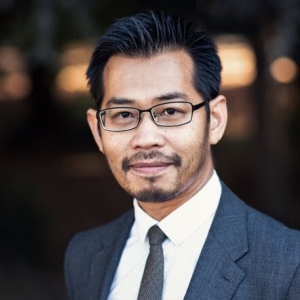
Let’s assume for a moment that at some point in the coming years – we can hope sooner rather than later – we do develop in-space propulsion using fusion. The easiest approach is to contrast working fusion with the methods available to us today. New Horizons was, shortly after launch, the fastest spacecraft ever built; it crossed the orbit of the Moon in a scant 9 hours, but it took a decade to reach Pluto/Charon. We can use gravity assists to sling a payload to the Kuiper Belt, perhaps a craft like JHU/APL’s Interstellar Probe concept, but here we’re dependent on planetary geometry, which isn’t always cooperative, and doesn’t provide the kind of boost that fusion could.
Image: Setthivoine You, co-founder and chief scientist at Helicity Space.
I’m a great advocate of sails, both solar sails and so-called ‘lightsails’ driven by beamed energy, but if reaching a distant target fast is the goal, we’re constrained by the need for a large laser installation and the likelihood, in the near future anyway, of pushing sails that are tiny. New Horizons would take two centuries to reach the Sun’s gravitational lens, a target of JPL’s SGL mission, which will use tight perihelion passes of multiple craft to get up to speed. We continue to talk about decades of travel time, even within the Solar System. As for interstellar, Breakthrough Starshot’s tiny craft, perhaps sent as a swarm to Proxima Centauri, might reach the target in 20 years if all goes well, but data return is a huge problem, and the mission can only be a flyby.
Helicity boldly sketches a future in which we might combine Interstellar Probe and the SGL mission into a single operation using a craft capable of taking a 5 ton payload to the gravitational lens (roughly 600 AU) in a little over a decade. Pluto becomes reachable in some of the Helicity concepts in about a year, with a craft carrying far heavier payloads than New Horizons and abundant power for operations and communications. All this in craft that could be carried into space by existing vehicles like Falcon Heavy or the SLS. The vision reminds us of The Expanse – imagine 4 months to Mars carrying 450 tons of payload as one step along the way.
All of this is a science fictional vision, but the work coming out of Helicity’s labs is solid. It involves so-called peristaltic magnetic compression to compress plasma and raise energy density. The method relies on specific stable behaviors within the plasma, a type of ‘Taylor State’ – these describe plasma within strong magnetic fields – discovered by You. These confine the plasma, while magnetic reconnection heating preheats it in the first place. Setthivoine You describes all this in the video, noting that what Helicity is developing is a method that we can consider magneto-inertial confinement, one producing a plasma jet stabilized through shear flows within the plasma itself. The firm’s computer simulations, in collaboration with Los Alamos National Laboratories, show four jets merging in a double-helix fashion inside the magnetic nozzle. You’s slides, available in the video, are instructive and dramatic.

What emerges from these results is scalable performance, allowing a path forward that the firm hopes to test as early as 2026 in a demonstration flight in orbit, with the possibility of a functional spacecraft at TRL 9 within roughly a decade. The scalable design points to the possibility of compact, reusable spacecraft with the unique feature of continuous thrusting. Think of the Helicity system, Stern has suggested, as a kind of afterburner put onto an electric propulsion system, and one that can scale into a working fusion drive. The concept scales by adding more fusion jets, allowing higher and higher efficiency, until the engine eventually becomes self-sustaining – the energy required to sustain the thrust is less than what the fusion begins to generate.
Does Helicity’s technology have the inside track, or will a contender like the UK’s Pulsar Fusion get to in-space fusion first? The latter is working on a study with Princeton Satellite Systems to examine plasma characteristics in a fusion rocket engine. Helicity’s founders are appropriately cautious about their work and stress how much needs to be learned, but they are continuing to develop the concept in their prototypes. With its laboratory in Pasadena, the company is privately funded and maintains active collaborations with Caltech and Los Alamos as well as UMBC and Swarthmore. Grants from the Department of Energy and other sources have likewise contributed. Have a look at the Montreal video to get a sense of where this exciting research stands, and also a glimpse of the kind of future that in-space fusion propulsion could produce.

Save New Horizons
The idea that we might take an active, working spacecraft in the Kuiper Belt and not only repurpose it for a different task (heliophysics) but also dismiss the team that is now running it is patently absurd. Yet this appears to be a possibility when it comes to New Horizons, the remarkable explorer of Pluto/Charon, Arrokoth, and the myriad objects of the Kuiper Belt. NASA’s Science Mission Directorate, responding to a 2022 Senior Review panel which had praised New Horizons, is behind the controversy, about which you can read more in NASA’s New Horizons Mission Still Threatened.
So absurd is the notion that I’m going to assume this radical step, apparently aimed at ending the Kuiper Belt mission New Horizons was designed for on September 30 of 2024, will not happen, heartened by a recent letter of protest from some figures central to the space community, as listed in the above article from Universe Today. These are, among a total of 25 planetary scientists, past Planetary Society board chair Jim Bell, Lori Garver (past Deputy Administrator of NASA), Jim Green (Past Director of NASA’s Planetary Science Division), Candice Hansen-Koharcheck (Past chair of the American Astronomical Society’s Division of Planetary Sciences and Past Chair of NASA’s Outer Planets Assessment Group), author Homer Hickham, Wesley T. Huntress (Past Director of NASA’s solar system Exploration Group), astrophysicist Sir Brian May, and Melissa McGrath (past NASA official and AAS Chair of DPS).
Needless to say, we’ll keep a wary eye on the matter (and I’ve just signed the petition to save the original mission), but let’s talk this morning about what New Horizons is doing right now, as the science remains deeply productive. I like the way science team member Tod Lauer spoke of the spacecraft’s current position in a recent post on the team’s website, a place where “It’s still convenient to think of neat north and south hemispheres to organize our vista of the sky, but the equator is now defined by the band of the galaxy, not our spinning Earth, lost to us in the glare of the fading Sun.”
Places like that evoke the poet in all of us. Lauer points out that the New Horizons main telescope is no more powerful than what amateur stargazers willing to open their checkbooks might use in their backyards. Part of the beauty of the situation, though, is that New Horizons moves in a very dark place indeed. While I have vivid memories of seeing a glorious Milky Way bisecting the sky aboard a small boat one summer night on Lake George in the Adirondacks, how much more striking is the vantage out here in the Kuiper Belt where the nearest city lights are billions of kilometers away?
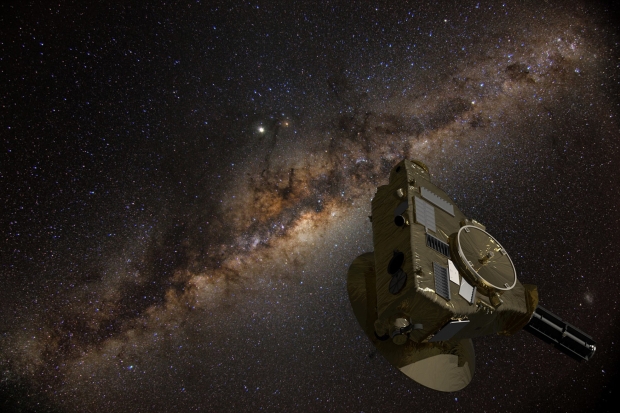
Image: A Kuiper Belt explorer looks into the galaxy. Credit: Serge Brunier/Marc Postman/Dan Durda
The science remains robust out here as well. Consider what Lauer notes in his article. Looking for Kuiper Belt objects using older images, the New Horizons team found that in all cases, even objects far from the Milky Way’s band appeared against a background brighter than scientists can explain, even factoring in the billions of galaxies that fill the visible cosmos. The puzzle isn’t readily solved. Says Lauer:
…we then tried observations of a test field carefully selected to be far away from the Milky Way, any bright stars, clouds of dust – or anything, anything that we could think of that would wash out the fragile darkness of the universe. The total background was much lower than that in our repurposed images of Kuiper Belt objects – but by exactly the amount we expected, given our care at pointing the spacecraft at just about the darkest part of the sky we could find. The mysterious glow is still there, and more undeniable, given the care we took to exclude anything that would compete with the darkness of the universe, itself. You’re in an empty house, far out in the country, on a clear moonless night. You turn off all the lights everywhere, but it’s still not completely dark. The billions of galaxies beyond our Milky Way are still there, but what we measure is twice as bright as all the light they’ve put out over all time since the Big Bang. There is something unknown shining light into our camera. If it’s the universe, then it’s just as strong, just as bright, as all the galaxies that ever were.
Only New Horizons can do this kind of work. How far are we from Earth? Take a look at the animated image below, which is about as vivid a reminder as I can find.
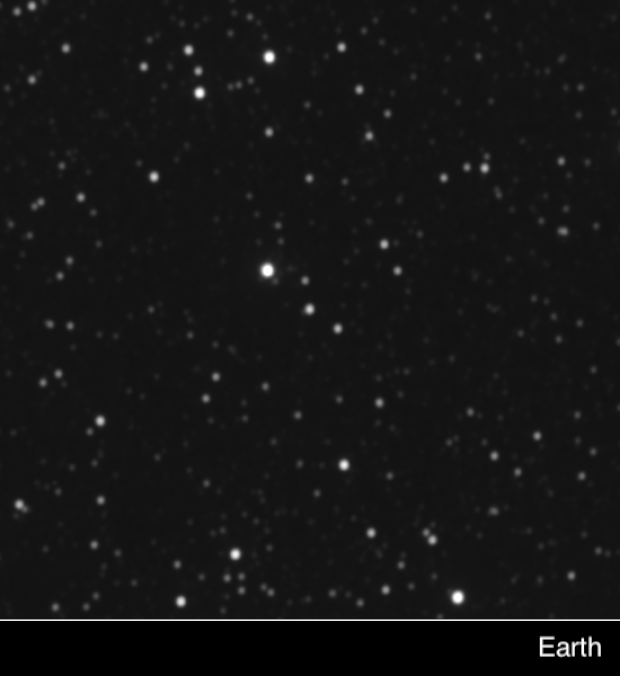
Image: Two images of Proxima Centauri, one taken by NASA’s New Horizons probe and the other by ground-based telescopes. The images show how the spacecraft’s view, from a distance of 7 billion kilometers, is very different from what we see on Earth, illustrating the parallax effect. Credit: NASA/Johns Hopkins Applied Physics Laboratory/Southwest Research Institute/Las Cumbres Observatory/Siding Spring Observatory.
With 15 more dark fields slated for examination this summer, New Horizons remains active on this and many other fronts. In his latest PI’s Perspective, Alan Stern notes the eight-week period of observations taking place now and through September. include continued observations of KBOs, imaging of the ice giants, dust impact measurements, mapping of hydrogen gas in the outer heliosphere, analysis using the ultraviolet spectrometer to look for structures in the interstellar medium, and spatial variations in the visible wavelength background. Six months of data return will be needed to download the full set for the planetary, heliospheric and astrophysics communities.
According to Stern, new fault protection software will allow New Horizons to operate out to 100 AU. That assumes we’ll still be taking Kuiper Belt data. Given the utterly unique nature of this kind of dataset and the fact that this spacecraft is engaged in doing exactly what it was designed to do, it is beyond comprehension that its current mission might be threatened with a shakeup to the core team or a reframing of its investigations. I’ve come across the National Space Society’s petition to save the New Horizons Kuiper Belt mission late, but please take this chance to sign it.

Rethinking Planet 9
Trans-Neptunian Objects, or TNOs, sound simple enough, the term being descriptive of objects moving beyond the orbit of Neptune, which means objects with a semimajor axis greater than 30 AU. It makes sense that such objects would be out there as remnants of planet formation, but they’re highly useful today in telling us about what the outer system consists of. Part of the reason for that is that TNOs come in a variety of types, and the motions of these objects can point to things we have yet to discover.
Thus the cottage industry in finding a ninth planet in the Solar System, with all the intrigue that provides. The current ‘Planet 9 Model’ points to a super-Earth five to ten times as massive as our planet located beyond 400 AU. It’s a topic we’ve discussed often in these pages. I can recall the feeling I had long ago when I first learned that little Pluto really didn’t explain everything we were discovering about the system beyond Neptune. It simply wasn’t big enough. That pointed to something else, but what? New planets are exciting stuff, especially when they are nearby, as the possibility of flybys and landings in a foreseeable future is real.

Image: An artist’s illustration of a possible ninth planet in our solar system, hovering at the edge of our solar system. Neptune’s orbit is show as a bright ring around the Sun. Credit: ESO/Tom Ruen/nagualdesign.
But a different solution for a trans-Neptunian planet is possible, as found in the paper under discussion today. Among the active researchers into the more than 1000 known TNOs and their movements are Patryk Sofia Lykawka (Kobe University) and Takashi Ito (National Astronomical Observatory of Japan), who lay out the basics about these objects in a new paper that has just appeared in The Astronomical Journal. The astronomers point out that we can use them to learn about the formation and evolution of the giant planets, including possible migrations and the makeup of the protoplanetary disk that spawned them. But it’s noteworthy that no single evolutionary model exists that would explain all known TNO orbits in a unified way.
So the paper goes to work on such a model, and while concentrating on the Kuiper Belt and objects with semimajor axes between 50 and 1500 AU, the authors pin down four populations, and thus four constraints that any successful model of the population must explain. The first of these are detached TNOs, meaning objects that are outside the gravitational influence of Neptune and thus not locked into any mean motion resonance with it. The second is a population the authors consider statistically significant, TNOs with orbital inclinations to the ecliptic above 45 degrees. This population is not predicted by existing models of early Neptune migration.
The paper is generous with details about these and the following two populations, but here I’ll just give the basics. The third group consists of TNOs considered to be on extreme orbits. Here we fall back on the useful Sedna and other objects with large values for perihelion of 60 AU or more. These demand that we find a cause for perturbations beyond the four giant planets, possibly even a rogue planet’s passing. Any model of the outer system must be able to explain the orbits of these extreme objects, an open question because interactions with a migrating Neptune do not suffice.
Finally, we have a population of TNOs that are stable in various mean motion resonances with Neptune over billions of years – the authors call these “stable resonance TNOs” – and it’s interesting to note that most of them are locked in a resonance of approximately 4 billion years, which points to their early origin. The point is that we have to be able to explain all four of these populations as we evolve a theory on what kind of objects could produce the observable result.
What a wild place the outer Solar System would have been during the period of planet formation. The authors believe it likely that several thousand dwarf planets with mass in the range of Pluto and “several tens” of sub-Earth and Earth-class planets would have formed in this era, most of them lost through gravitational scattering or collisions. We’ve been looking at trans-Neptunian planet explanations for today’s Kuiper Belt intensely for several decades, but of the various suggested possibilities, none explained the orbital structure of the Kuiper Belt to the satisfaction of Lykawka and Ito. The existing Planet 9 model here gives way to a somewhat closer, somewhat smaller world deduced from computer simulations examining the dynamical evolution of TNOs.
What the authors introduce, then, is the possibility of a super-Earth perhaps as little as 1.5 times Earth’s mass with a semimajor axis in the range of 250 to 500 AU. The closest perihelion works out to 195 au in these calculations, with an orbit that is inclined 30 degrees to the ecliptic. If we plug such a world into this paper’s simulations, we find that it explains TNOs that are decoupled from Neptune and also many of the high-inclination TNOs, while being compatible with resonant orbit TNOs stable for billions of years. The model thus broadly fits observed TNO populations.
But there is a useful addition. In the passage below, the italics are mine:
…the results of the KBP scenario support the existence of a yet-undiscovered planet in the far outer solar system. Furthermore, this scenario also predicts the existence of new TNO populations located beyond 150 au generated by the KBP’s perturbations that can serve as observationally testable signatures of the existence of this planet. More detailed knowledge of the orbital structure in the distant Kuiper Belt can reveal or rule out the existence of any hypothetical planet in the outer solar system. The existence of a KBP may also offer new constraints on planet formation and dynamical evolution in the trans-Jovian region.
A testable signature is the gold standard for a credible hypothesis, which is not to say that we will necessarily find it. But if we do locate such a world, or a planet corresponding to the more conventional Planet 9 scenarios, we will have ramped up our incentive to explore beyond the Kuiper Belt, an incentive already given further impetus by our growing knowledge of the heliosphere and its interactions with the interstellar medium. But to the general public, interstellar dust is theoretical. An actual planet – a place that can be photographed and one day landed upon – awakens curiosity and the innate human drive to explore with a target that pushes all our current limits.
The paper is Lykawka & Ito, “Is There an Earth-like Planet in the Distant Kuiper Belt?,” Astronomical Journal Vol. 166, No. 3 (25 August 2023) 118 (full text).

